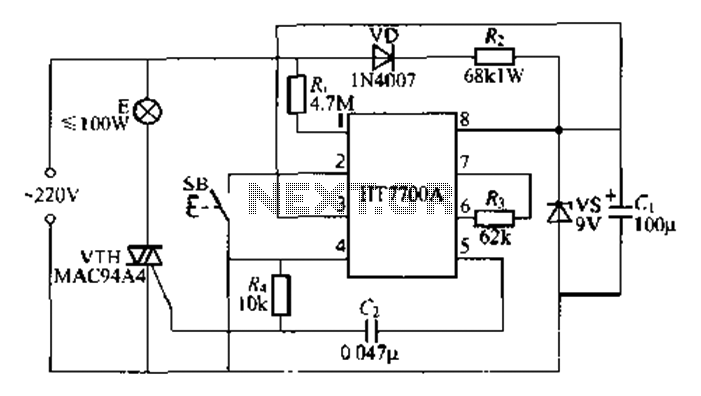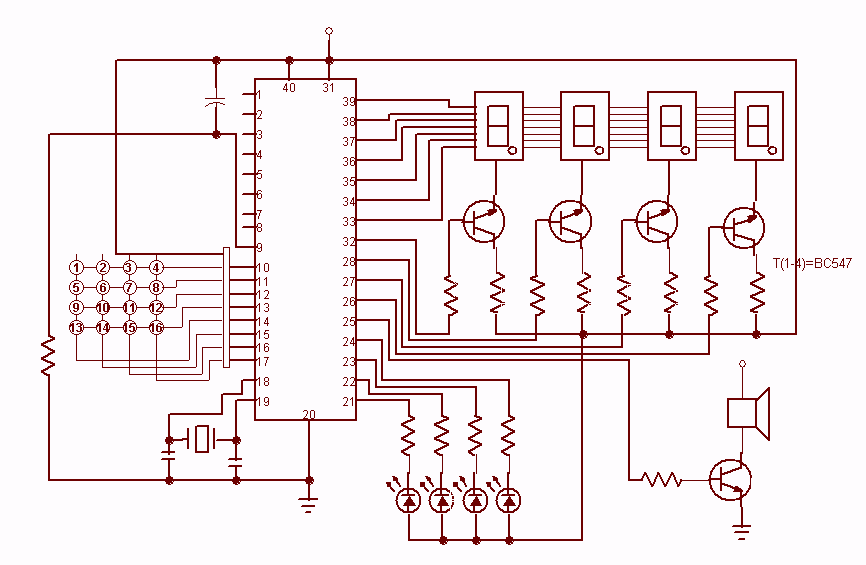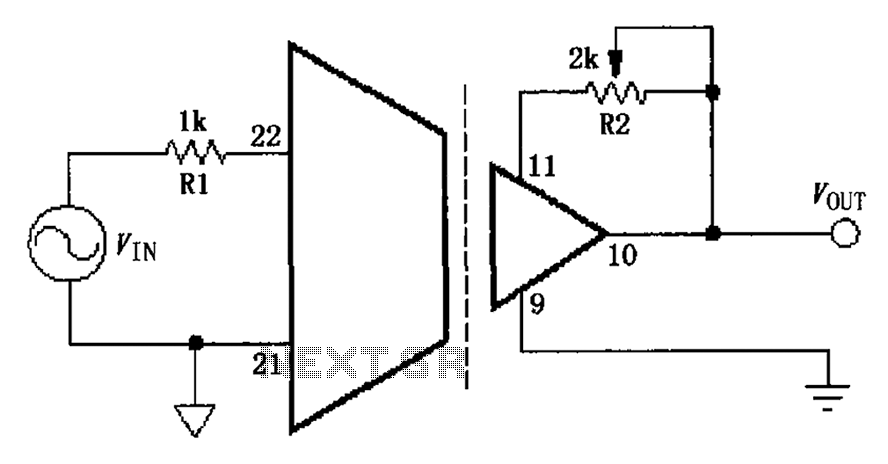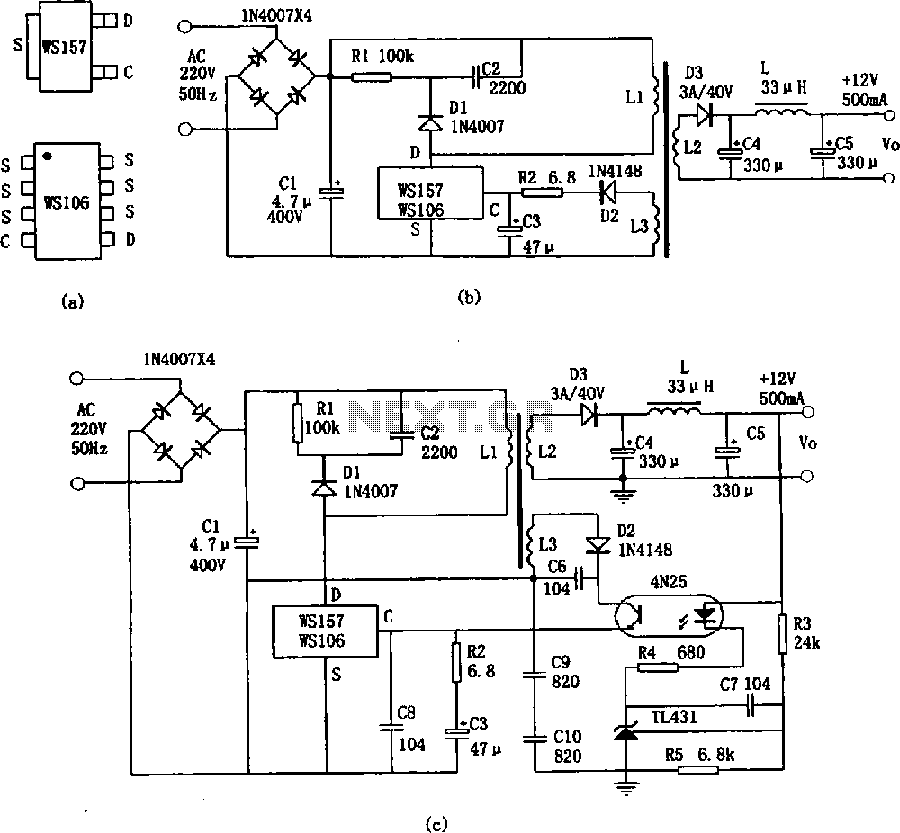
ASIC stepless dimming lamp circuit

The HT7700A ASIC is designed for stepless dimming of lights, utilizing a single button control mechanism. It offers 96 levels of brightness adjustment. The HT7700A is fabricated using a CMOS process and comes in a standard D1P-S-pin package. The pin functions are as follows: Pin 1 is the zero-crossing detection signal terminal for alternating current; Pin 2 serves as a touch sensor/key signal input terminal; Pin 3 functions as the input for the touch signal current; Pin 4 is the power source negative terminal; Pin 5 is the trigger output for activating the thyristor; Pins 6 and 7 provide oscillation signal outputs, with respective input terminals; and Pin 8 is the power source positive terminal.
The HT7700A ASIC is an integrated circuit specifically developed for applications requiring precise light dimming capabilities. The device operates on a principle that allows for smooth transitions in brightness, enhancing user experience in lighting control. The single-button interface simplifies operation, enabling users to easily adjust brightness levels across a range of 96 settings.
The zero-crossing detection feature at Pin 1 is crucial for minimizing electrical noise and ensuring efficient power management, as it allows the circuit to switch the load at the moment when the AC voltage crosses zero, thus reducing inrush current and electromagnetic interference. The touch sensor input at Pin 2 allows for intuitive user interaction, where a simple touch can register as a command, contributing to a user-friendly design.
The current input at Pin 3 is essential for the functionality of the touch sensor, as it helps in detecting the presence of a touch and converting it into a corresponding signal for processing. The negative terminal at Pin 4 is a standard connection point for grounding the circuit, ensuring stable operation and minimizing potential noise in the system.
Pin 5's trigger output is designed to control a thyristor, which is a semiconductor device used for switching and controlling power. This allows the HT7700A to effectively manage the power delivered to the lighting system, facilitating the dimming function.
Pins 6 and 7 are dedicated to oscillation signal outputs, which are critical for the internal timing and control functions of the ASIC. These oscillation signals are generated based on external resistor values, which can be adjusted to influence the performance characteristics of the dimming function. Lastly, Pin 8 serves as the positive terminal for the power supply, providing the necessary voltage for the operation of the ASIC.
Overall, the HT7700A ASIC is a sophisticated solution for modern lighting applications, combining ease of use with advanced electronic features to achieve efficient and effective light dimming.Is using a dimmer HT7700A ASIC production keyed stepless dimming lights, make use SB single button control, dimming the brightness has 96 changed. HT7700A scale using CMOS process is made using standard D1P-S-pin package. Preparation of the pin cylinder functions as follows: The first O feet zC alternating current zero-crossing detection signal terminal; first feet SFNSI // KEY as a touch sensor / key signal input terminal; first feet FB when touch input signal current fed ; first leg V ;., Power source negative terminal; first feet IRIC, trigger output for triggering the thyristor;. The first and foot OSC2 OSC1 oscillation signal output, respectively, an input terminal, an external resistor F 62kn first feet v.
., Power source positive terminal.
The HT7700A ASIC is an integrated circuit specifically developed for applications requiring precise light dimming capabilities. The device operates on a principle that allows for smooth transitions in brightness, enhancing user experience in lighting control. The single-button interface simplifies operation, enabling users to easily adjust brightness levels across a range of 96 settings.
The zero-crossing detection feature at Pin 1 is crucial for minimizing electrical noise and ensuring efficient power management, as it allows the circuit to switch the load at the moment when the AC voltage crosses zero, thus reducing inrush current and electromagnetic interference. The touch sensor input at Pin 2 allows for intuitive user interaction, where a simple touch can register as a command, contributing to a user-friendly design.
The current input at Pin 3 is essential for the functionality of the touch sensor, as it helps in detecting the presence of a touch and converting it into a corresponding signal for processing. The negative terminal at Pin 4 is a standard connection point for grounding the circuit, ensuring stable operation and minimizing potential noise in the system.
Pin 5's trigger output is designed to control a thyristor, which is a semiconductor device used for switching and controlling power. This allows the HT7700A to effectively manage the power delivered to the lighting system, facilitating the dimming function.
Pins 6 and 7 are dedicated to oscillation signal outputs, which are critical for the internal timing and control functions of the ASIC. These oscillation signals are generated based on external resistor values, which can be adjusted to influence the performance characteristics of the dimming function. Lastly, Pin 8 serves as the positive terminal for the power supply, providing the necessary voltage for the operation of the ASIC.
Overall, the HT7700A ASIC is a sophisticated solution for modern lighting applications, combining ease of use with advanced electronic features to achieve efficient and effective light dimming.Is using a dimmer HT7700A ASIC production keyed stepless dimming lights, make use SB single button control, dimming the brightness has 96 changed. HT7700A scale using CMOS process is made using standard D1P-S-pin package. Preparation of the pin cylinder functions as follows: The first O feet zC alternating current zero-crossing detection signal terminal; first feet SFNSI // KEY as a touch sensor / key signal input terminal; first feet FB when touch input signal current fed ; first leg V ;., Power source negative terminal; first feet IRIC, trigger output for triggering the thyristor;. The first and foot OSC2 OSC1 oscillation signal output, respectively, an input terminal, an external resistor F 62kn first feet v.
., Power source positive terminal.





